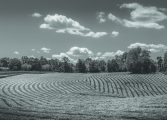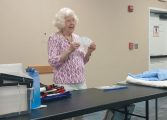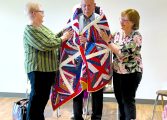Other than a few workshops, Bethke is mainly self-taught. Her work is unique for someone who never studied art in a classroom but still took the time to study and learn.
She explained that the key to becoming a good artist is being able to see; being able to distinguish lines, shapes and color and visualize their relationship does not come easily.
“Common frustrations with watercolor are fear of lights and darks and where to add them, how to preserve the white areas of the paper, making mud and a weak composition,” she said.
Bethke discussed the tools she uses to create her paintings. Much of Bethke’s work is dry brush as opposed to wet-on-wet technique used in watercolor. Paper is another important element when it comes to choosing the right tools.
“The paper is the most important tool; it’s number one,” she said. She uses Arches cold press 140 lb. and 300 lb. as well as Fabriano Studio paper for practice. As for paint, she used to use Windsor Newton but likes Holbein and M. Graham. For landscape painters she recommends the M. Graham, particularly for their greens.
She discussed the age-old rule that watercolorists must leave white areas pure, with only the white of the paper showing through, but many often wonder how to do this. She suggested using what’s called liquid frisket or masking fluid. Some had never tried it.
She begins her work with a sketch and uses masking fluid to maintain the white areas, then uses a yellow wash in one painting she used to describe the process. The wash is often referred to as the underpainting. She then begins building color through a process known as glazing.
“Colors are useless from the tube, mixing is necessary to get a natural look,” she said. Her technique is not to mix colors into one another, which results in a muddy mess, but to sweep a little color into another with a little water on the brush for a more subtle effect.
“Best way to paint an area, walk away and let it dry. Come back to it later and add more detail,” she said. She explained in more detail the process of glazing, which enriches color, deepens and adds shadows, and creates beautiful layers.
She mentioned Ivan Aivazovsky and Albert Bierstadt among some of the masters that have influenced her. She used their work to describe what was attractive about their paintings.
“Their paintings have captivating lights and darks and use of color,” she said, also pointing out their strengths in effective balance and texture among the techniques that bolster the focal point of their compositions.
“As an artist you need to take liberties with lights and darks, knowing how to break them up,” she said. The artist must decide what is important about the subject and not just copy it literally.
Bethke stressed that art is not always a free form of expression as most would expect, but instead requires planning.
“Plan, plan, plan and paint,” she said. “People imagine watercolor painting as being free, loose and a spontaneous activity, and there are times to paint this way. I do believe that watercolors should have areas where paint bleeds and creates interest and surprising beauty but I am always successful when I have planned spontaneity.”
Bethke has found her signature style. “I’ve learned to loosen up instead of working every blade of grass,” she said.
Bethke was animated as she spoke and her enthusiasm for the visual arts was clear when she said, “Being creative is being in love with life.” Only an artist would understand the true meaning of her statement.
Linda Bethke teaches private art classes to small groups. If interested, contact her at LSB525@aol.com.




